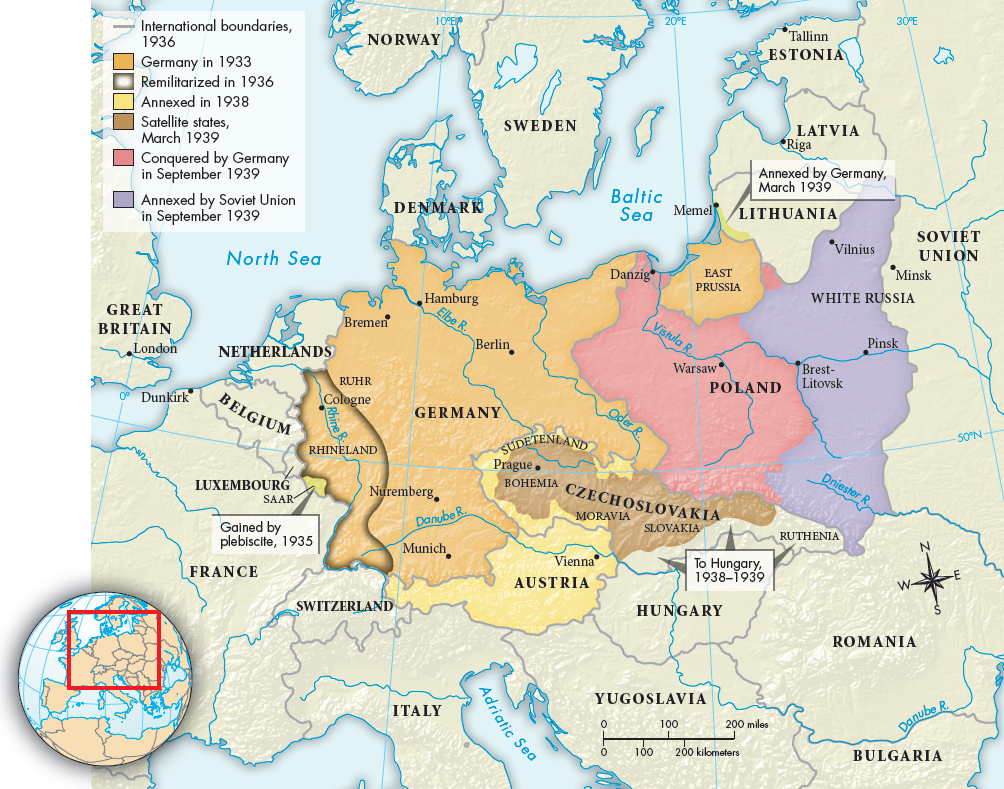A History of World Societies:
Printed Page 936
A History of World Societies Value
Edition: Printed Page 948
Aggression and Appeasement, 1933–1939
After Germany’s economic recovery and Hitler’s success in establishing Nazi control of society, he turned to the next item on his agenda: aggressive territorial expansion. He camouflaged his plans at first, for the Treaty of Versailles limited Germany’s army to only a hundred thousand men. Thus, while Hitler loudly proclaimed his peaceful intentions, Germany’s withdrawal from the League of Nations in October 1933 indicated its determination to rearm. When in March 1935 Hitler established a general military draft and declared the “unequal” Versailles treaty disarmament clauses null and void, leaders in Britain, France, and Italy issued a rather tepid joint protest and warned him against future aggressive actions.

But the emerging united front against Hitler quickly collapsed. Britain adopted a policy of appeasement, granting Hitler everything he could reasonably want (and more) in order to avoid war. British appeasement, which practically dictated French policy, had the support of many powerful British conservatives who, as in Germany, underestimated Hitler. They believed that Soviet communism was the real danger and that Hitler could be used to stop it. The British people, still horrified by the memory, the costs, and the losses of the First World War, generally supported pacifism rather than war. Some British leaders at the time, however, such as Winston Churchill, bitterly condemned appeasement as peace at any price. After the war, British appeasement came to be viewed as “the granting from fear or cowardice of unwarranted concessions in order to buy temporary peace at someone else’s expense.”23 Beginning in the 1990s some historians have argued that British leaders had no real choice but to appease Hitler in the 1930s, because neither Great Britain nor France was prepared psychologically or militarily to fight another war.24 In March 1936 Hitler suddenly marched his armies into the demilitarized Rhineland, brazenly violating the Treaties of Versailles and Locarno. France would not move without British support, and Britain refused to act. As Britain and France opted for appeasement and the Soviet Union watched all developments suspiciously, Hitler found powerful allies. In October 1935 the bombastic Mussolini attacked the independent African kingdom of Ethiopia. The Western powers and the League of Nations condemned Italian aggression, but Hitler supported Italy energetically. In October 1936 Italy and Germany established the so-
At the same time, Germany and Italy intervened in the Spanish Civil War (1936–
In late 1937 Hitler moved forward with his plans to crush Austria and Czechoslovakia as the first step in his long-

Simultaneously, Hitler demanded that the pro-

Hitler’s armies occupied the remainder of Czechoslovakia in March 1939. This time, there was no possible rationale of self-
Through the 1930s Hitler had constantly referred to ethnic Slavs in the Soviet Union and other countries as Untermenschen (inferior people), and relations between the two countries had grown increasingly tense. War between Germany and the Soviet Union seemed inevitable, and, indeed, Stalin believed that Great Britain and France secretly hoped the Nazis and Bolsheviks would destroy each other. In an about-
For Hitler, everything was now set. He told his generals on the day of the nonaggression pact, “My only fear is that at the last moment some dirty dog will come up with a mediation plan.”27 On September 1, 1939, the Germans attacked Poland from three sides. Two days later, Britain and France, finally true to their word, declared war on Germany. The Second World War had begun.